There are a series of bodybuilding poses that are mandatory for all professional championships. The same "posing" is required in all categories of professional bodybuilding, with the exception of Men's Physique, which has its own repertoire of postures. Maybe you are not a professional bodybuilder, but you have sometimes posed at the gym or in front of a mirror at home. Are you sure you know how to show your muscles well?
Posing for bodybuilding is an art and also a way to realize your gains and progress. To do it well, you have to work hard and connect your mind with your muscles as much as possible. It doesn't matter if you are a professional bodybuilder or just love lifting weights and flexing your muscles. Know every bodybuilding pose to show off your muscles well in front of a judge (or in the fitness poses of your best Instagram photo; why not?
The importance of posing in bodybuilding
In the world of competition, it is as important to have worked your muscles in the gym and stay lean as it is to know how to show what you have . Posing is an essential part of staging. It's no use having developed huge biceps, a good chest or giant quads if you don't know how to take advantage of your image. You have to know how to tighten the muscle so that the cuts and striations, the pumping, the fibers can be seen... It is not an easy task to master, but it can make a difference on stage. A good poser can defeat a bodybuilder with a better physique if he knows how to show himself.
In bodybuilding there are mandatory or regulatory poses , which are required of the bodybuilder during competition so that judges and spectators can see muscle size and definition; and free poses , which allow the athlete's creativity to come out so that he can exploit his strengths. Regulation poses , of course, are the most important.
There are 8 mandatory bodybuilding poses during competitions. Basically, they consist of flexing and contracting muscles in different ways. Bodybuilding postures are just a special artistic way of showing off. The posing routine allows the athlete to show each area of their body at maximum contraction. A posing routine is nothing more than a combination of consecutive postures. Imagine bodybuilding as a physical work of art. Therefore, presentation is important. Bodybuilding has given rise to the best push-up poses for competition. Each bodybuilder must learn the postures and perfect their posing routine individually.
In competitions, it is common for mandatory postures to be carried out at established times. The bodybuilder may then choose to finish the routine with a quick pose, which may include other optional postures. Creativity is allowed. Let's see all the bodybuilding poses and their names .
It is convenient to know the names of the bodybuilding poses in English because that is how they are known internationally. When the bodybuilder competes in international championships, the judges will ask for the poses in English.
Names of poses in bodybuilding
- Front Lat Spread
- Front Double Bicep
- Side Chest
- Rear Lat Spread
- Rear Double Biceps
- Side Triceps
- Abdominal and Thigh
- Most Muscular
Front Bodybuilding Poses
As the term indicates, these postures are used to evaluate the front part of the body: the biceps, pectorals, abdomen, quadriceps... There is debate about whether front poses or back poses are more important in bodybuilding . The phrase "Mr. Olympia is won with a good double biceps back pose" has been heard many times. However, the consensus among professionals seems to indicate that what scores the most is the bodybuilder's frontal view. It's important to improve both types of poses (front and back), but make sure you look good, especially from the front.
Front Double Biceps
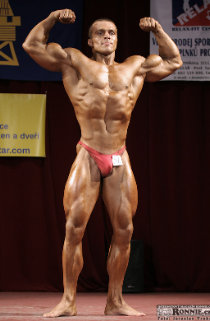
This is the first of eight mandatory poses in bodybuilding competitions. The front double biceps serve to show the muscles of the arms. Here, the judge will pay attention to the size and height of the biceps. This pose accentuates the shape and size of the arms and even shows the size of the forearm. Other things that show up with this position are also the width of the lat, the size and definition of the quads, and the front of the calves. This is perhaps the most important position.
- Bend your legs slightly and try to push your quads outwards slightly (as if you were starting the movement of kicking a ball).
- Fill the ribcage well with air and squeeze the abdomen tightly. Once your lungs are full of air, you will have to take small breaths without ever completely releasing the air to maintain this position.
- Flex your biceps strongly symmetrically, making fists and bringing your fists closer to your head. Your arms and feet should be at the same height. You don't have to arch your back too far back in this pose; Don't bring your arms forward either (you should keep them in line with your head). The biceps must be facing the judges.
Don't forget to contract all the muscles: such as biceps, abdomen and quadriceps. In addition, the chest must remain well filled with air at all times.
Some athletes look best doing abdominal vacuums in this pose. This is a matter of athlete preference.
Front Lat Spread
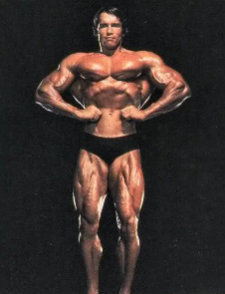
The front dorsal expansion is one of the most practiced poses by bodybuilders. The objective of this position is to show the front width of the dorsal. Also the thickness of the chest and the width of the deltoids. The arms and legs will also be seen in this bodybuilding pose. The judges will pay attention to the size of the arm and forearm. They will be able to see the muscle and striations of the quadriceps, as well as the development of the calf seen from the front.
- You have to place your legs as we explained for the double biceps position. Bend your knees a little and try to rotate your legs slightly to draw your quadriceps outwards. Don't spread your legs too far apart. About 20 cm between them will be enough.
- Close your fists and place them on your waist. Your thumbs should be on the back of your oblique abdominals. You can "hook" your thumbs right at the top of your hip bone so your hands don't slide. Press your waist with your fists to make it narrower and make your shoulder girdle appear wider. You will achieve the desirable "V" shape.
- Then, open and bring your elbows forward to achieve front-facing dorsal expansion.
- Take a breath, raise your pectoral and bring it out with the maximum contraction. Then, maintain an isometric posture on the pectoral muscle. Take small breaths (like small apneas) without completely releasing the air from your lungs so as not to lose chest width.
- Remember to tighten all your muscles in the pose: your back, chest, arms and legs. Try to narrow your waist as much as you can.
Abdominal and Thigh
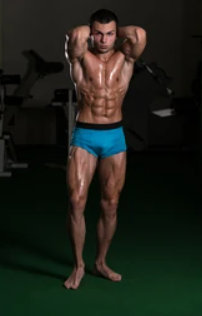
Abs will always be important in bodybuilding. This bodybuilding pose serves to accentuate the abs and leg . You will have to flex your abdominal muscles, external intercostal muscles, serratus anterior and quadriceps. You can also show the thickness of your chest and arm with this posture. Also the size of the forearm and, again, the width and size of the calf. Variations of this posture can be made. In the classic bodybuilding pose, both arms are overhead while the abs are flexed from the front. In another version of this pose, athletes raise both arms or just one above the head and then flex the abdominals to each side to show definition of the obliques and intercostals.
- We stand facing each other. You should not put your hands right behind your head or your elbows too far apart. We will lower our hands towards the never, raise our elbows and keep them close to the head. You have to squeeze your abs hard. Normally, one of the legs is placed forward, raising the calf slightly (to show the muscular definition of the calf).
- On the front leg, it is important to do the isometric gesture of "kicking a ball" and contract the quadriceps well to show all the muscles.
- Don't make the mistake of taking all the air out of your lungs because you will only make your torso look very small (which the judges won't like). You have to tighten your abdomen, but keep the air in your rib cage.
- You can switch to the front leg to show that you have good muscle development in both thighs. Another alternative is to place both legs at the same height and squeeze them at the same time.
- If you want, you can do a biceps pose with one of your arms. Here, the bodybuilder's creativity comes into play.
Most Muscular
This bodybuilding pose is not called for in all federations, but it is important to learn how to do it. The last position is called more muscular . With this posture, you can see all the development of your general muscles from the front, including the upper trapezius, shoulders, chest, forearms, biceps, abs, quads and calves. As in any ending, with this posture you must appear big and impressive. Flex every muscle you can. The basic version consists of placing your arms and hands on your stomach. You can also do a variation by placing one arm at your side and the other on your stomach, but you'll need to flex the same muscle groups.
- We squeeze the legs as we have explained in previous poses (small flexion in the knees and slight external rotation in the quadriceps).
There is a difference between the more muscular natural bodybuilding poses and these same poses in users with doping substances (more massive).
In natural bodybuilders :
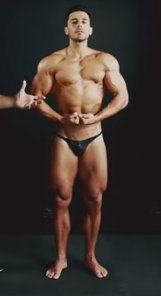
- Stand tall, joining your hands at the level of your navel and with your elbows pointing to the sides. Take a breath and tighten all the muscles in your body.
- Another version for naturals is to place the palms of the hands on both sides of the thighs, just below the hips, and then squeeze the abdomen and all the muscles. These poses flatter natural bodybuilders and make them look bigger.
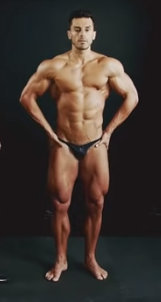
In bodybuilders with chemical aids :
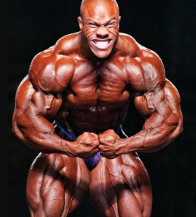
- Bodybuilders who use anabolics and other substances have great mass. They will be able to get more out of the pose if they join their arms in front of their abdomen and lean their body forward. Then, they will have to take a breath and tighten all the muscles of the body by contracting the biceps, trapezius, chest, abdomen and shoulders. Natural bodybuilders, with less muscle mass, simply look very thin when doing this bodybuilding pose.
Side Bodybuilding Poses
These postures are intended to help evaluate the athlete's body seen in profile. There are two profile poses that are mandatory.
Side Chest
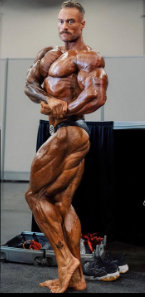
The famous side chest posture favored bodybuilder Arnold Schwarzenegger. The side chest pose shows the size and thickness of your chest from both sides. It is difficult to isolate the chest muscles well during training. Therefore, a developed pectoral is highly valued by the judges. You can choose to pose from the right or left side depending on how you feel most comfortable. Whichever side you choose, turn your body slightly to one side and then the other so the judges can get a good look at your chest. This pose also shows the size of the shoulders, arms and forearms in side view. Also don't forget the thighs and calves, which will also be seen from the side.
This posture is also called rib cage profile .
- The first thing is to place the legs. We will stand in profile and put our feet together. The legs will be slightly bent. The front of the foot of the leg that is positioned towards the judges will be at the level of the ankle of the other leg (which will be behind).
- In this pose, the femoral muscle is highly valued. The trick is to bring both legs together and use force with the leg that is behind. This technique will push the femoris of the visible leg and this muscle will appear larger to the judges. Strongly contract your gluteus and femoral muscles. To achieve this, push your legs against the floor. It is very important that, in this position, the separation between the femoral and the quadriceps is clearly visible.
Note: Some people look better leaving the hamstring relaxed rather than contracted (but pushing the muscle with the other leg). Keeping the hamstring relaxed can give a fuller appearance. You must assess which style of pose is best for you.
- Now, you have to position your arms. Flex the arm that is facing the judges and grab the wrist with the other arm. The lateral shoulder and biceps should face the judges. Don't raise the shoulder behind you too much!
- You must press the arm that is behind against the pectoral. Regarding the arm in front, remember to leave room for the oblique abdominals to be seen. Fill the ribcage with air.
- Regarding the position of the hands, you can consider two options. An alternative would be to raise your forearm up a little, as if you were doing an isometric biceps curl. Another possibility is to stick your lateral shoulder out to better show your deltoid (as if you were doing a lateral raise). Tighten your pectorals and biceps at all times. Don't make the mistake of putting your shoulder forward or bringing your elbow back!
Side Triceps
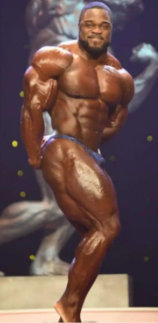
The protagonist in the lateral triceps posture is the triceps muscle. Specifically, it seeks to bring out the head of the lateral triceps. The triceps are responsible for making your arms look bigger. Learn to flex them in this position. You can choose which side you lean towards. Make sure the judges can also take a look at your lats by turning them slightly to each side. Additionally, it shows the size of your shoulders and chest, as well as the leg muscles that you have shown in all the other poses.
Choose the profile view you prefer (left or right side), although it is recommended that you work the pose with both sides to avoid having weak points.
- The position of the legs is the same as in the other lateral pose (side pectoral). Being positioned in profile, we will put our feet together. We will bend our legs a little so that the foot that is in front of the judges is aligned with the leg that is behind.
- We grab our hands behind the glutes and make sure to contract the triceps well. We will not separate the arm from the torso too much to avoid "gaps" being seen. We also squeeze the shoulder very well.
- In this pose, it is very important to keep the abdomen close to the trunk. Avoid "sticking your belly out." The abs should be a compact block.
- Rotate your torso a little so that the width of your shoulders can be seen. Remember that this pose is not only for the triceps, but also for the shoulders, abdomen and obliques, chest...
- Keep your ribcage full of air.
- It is essential to squeeze the gluteus in this pose.
Tricks: to make the arm look much larger in profile, a secret is to hide the wrist.
Please note that in front of the stage, there will be several bodybuilding judges. If you compete, you will have to show your muscles to all of them. Do several torso rotations so that all the evaluators can see you. But beware! Do the rotations with slow and harmonious movements. If you move abruptly, the poses will not look pretty.
Back Bodybuilding Poses
The last two are the bodybuilding poses with your back to the judges . With this, we will evaluate the athlete's posterior chain (which is as important as the frontal area). Now is the time to show how you have worked the femoral, calves, as well as the thickness and width of your back, mainly.
Rear Lat Spread
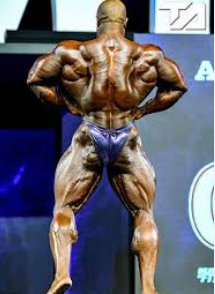
Like the front pose, the back expansion indicates the width of the back, but seen from behind. Instead of showing off your chest and front, this pose focuses on your trapezius, glutes, hamstrings, and the back of your calves.
- If both legs have the same muscle development and you can contract them with the same intensity, it is better for one leg to be left behind. The judges evaluate this positively.
- If you remember the front dorsal expansion position, the hands will be placed like in this pose. The fists rest on the waist and the thumbs behind the oblique abdominals. To prevent your hands from slipping, one trick is to tentatively wrap your thumbs around your waist and just above your hips. Press your fists to create a contrast between the width of the shoulders and the narrowness of the waist (the famous "V" silhouette).
- In this case, we will not contract the back as much, but we will try to expand it as much as possible, as if we wanted to wrap around a large tube located in front of us.
- Unlike other bodybuilding postures, the chest does not rise as much. The real focus of the pose will be the back. On the other hand, the neck becomes especially tense; You have to try to keep the neck aligned with the rest of the spine.
Rear Double Biceps
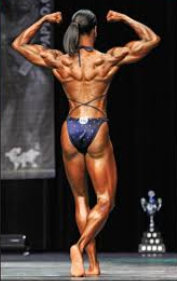
The back double biceps position shows the size and length of the biceps from behind. Your biceps and beak are visible again. This pose also shows off the thickness and definition of your back muscles. Things like the trapezius, infraspinatus, teres major, latissimus dorsi, and erector spinae should be contracted for the judges. Once again, the legs cannot be overlooked here either. The back double biceps shows the size of the glutes and hamstrings, as well as the calves when viewed from behind.
- With your back to the judges, one of the two legs is moved backwards and the heel is raised to promote the development of the gastrocnemius, hamstrings and glutes (while the front leg is contracted).
- The arms are raised as in the front biceps position, that is, until both are at shoulder height or slightly above. The elbows are bent at about 90º or more to reach the maximum "peak" of the biceps.
- In this position, it is important to contract not only the muscles of the arms, but also the shoulders and upper back. The relief created by the dorsal muscles will strongly stand out.
- We will raise the chest when we lean slightly back in order to emphasize the spinal cord of the lower back.
Relaxed Bodybuilding Poses
These are the first poses performed in front of the judges, before continuing with the regulation poses we have seen.
Front relaxed pose
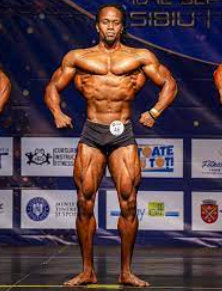
First of all, you must breathe! The more you try to hold your breath, the faster you will pass out or hyperventilate. Breathe from the diaphragm, but using shallow, slow and controlled breaths. Posing consists of optimizing illusions and postures according to your physical characteristics.
Learn to do the semi-relaxed front pose from the beginning. The first thing is to place the legs. Muscle fibers will appear as far apart as possible only when the muscles are tightly contracted.
- With your feet slightly shoulder-width apart, press your big toes into the ground, creating an arch (this actually forces your hips to abduct without moving your legs). Contract your gluteal muscles (hip extension) and try to do a kind of "glute bridge." It is essential to keep your glutes tight because this helps position your upper body. If we had to list the most important steps of this posture, after the legs we would have to control the abdominal wall.
- Pull the abdominal wall in and up by performing a "vacuum." Think that you want to draw your belly button to your spine (an isometric transverse abdominal contraction). Now is the time to expand!
- Squeeze the shoulder blades medially towards the spine without contracting the shoulders (retract and depress the shoulder blades).
- Push your chest toward the ceiling (pectoral extension). Keep your shoulder blades down as you swing your shoulder blade back and away from your body (pronation and abduction/upward rotation of the shoulder while trying to maintain external rotation).
Side relaxed
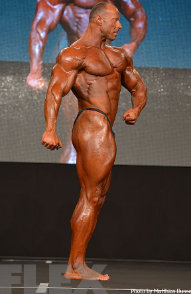
From the previous position you have to turn your body a quarter of a turn to move to the relaxed lateral posture :
- Place your left heel in the arch of your right foot. Use your right knee to squeeze your left hamstring toward the judges (right hip internal rotation), squeeze your glutes and hips to stay upright (hip extension).
- Similar to the relaxed front pose, introduce an abdominal vacuum. However, when doing the quarter turn, don't just think from your belly button to your spine, but also from your lower back to your spine. If you do it right, it will look like an abdominal void from both directions, which makes your waist appear narrower and makes you look bigger.
- Rotate and lower your arm behind your chest while pushing your chest up (shoulder lift to depression, retraction, gleniohumeral extension and thoracic extension).
Rear relaxed pose
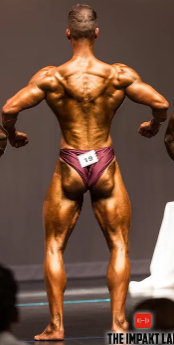
You have to complete a turn to the right to reach a semi-relaxed position on your back , which is practically the same position as the first, only you will try to show more contraction in the entire back part of the body.
- The legs will be at a distance of about 20 cm from each other, the knees slightly bent and the legs turned outwards about 20º so that the maximum possible width of the thighs can be seen. The glutes and hamstrings will contract by pressing the floor with your feet, as if you were doing the deadlift exercise with stiff legs.
- The body will also remain vertical while maintaining maximum chest expansion, and the arms will be separated from the body as in the relaxed forward posture. By isometrically narrowing the entire back and tilting it very slightly backwards, the waist area will be more visible.
Other side relaxed pose
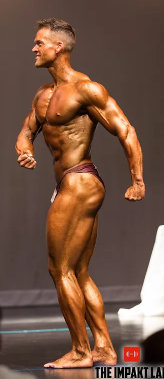
- Turn to the right again to perform the relaxed side pose with the other side. The points to highlight are the same as in the second pose.
- Finally, the twist ends in a relaxed front position, the technique of which we explained above.
Free poses in bodybuilding
When you master all the poses, it's time to create your own posing routine . Typically, after the mandatory poses , contestants have two minutes to do a custom pose. Then the judges decide who looks the best. This is your time to shine and bring out the best in you. If a body part is your strong point, adjust it. Do whatever pose you think will make you look better.
Just like with dancing, your posing routine should flow and look natural. Don't randomly jump from one position to another. Carefully plan each pose to show everything you want to show. A good rule of thumb would be to practice your routine at least once a week. Familiarize yourself with the positions and muscles until you remember not only the positions, but also the feel of the muscles flexed.
Are women's bodybuilding poses the same?
Almost all men's bodybuilding poses are the same women's bodybuilding poses . The only exception would be the "more muscular" posture. Men and women bodybuilders have to do the same thing when they go on stage. The type of mentions and posing routines are the same for both men and women. Also the evaluation is almost the same level. Judges analyze the size, symmetry and fullness of muscles in competitions of both sexes. Almost all men's and women's competitions are held one after another.
Are Classic Physique poses the same?
In some federations, dorsal expansion is not done in the Classic Physique category. All other poses are the ones we have explained.
Is there a difference between natural and doped bodybuilding poses?
No. They are the same poses for both modalities. It is only advisable to adapt the "more muscular" posture in natural users to prevent them from appearing too small.
Other optional bodybuilding poses
Below are some classic bodybuilding poses that have been used by the greatest professionals. If you've been following bodybuilding for a while, you've probably seen some of these poses performed. Let's now look at old bodybuilding poses .
The abdominal vacuum
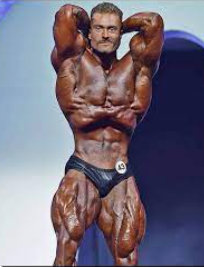
The "Vacuum" pose was one of the regulatory poses of classic bodybuilding (it is no longer required, but optional). The competitor must expand the chest, inhale all the air in the lungs and contract the abdominal muscles as much as possible.
It is a complicated technique that requires a lot of practice to obtain the correct results. The goal is to make your stomach look as hollow as possible below the ribs. When done well, the pose accentuates the V-taper and displays incredible muscle control. Most male bodybuilders cannot perform this pose because they are too massive. The Classic Physique division, which favors a small waist, highlights this pose to differentiate itself from the "Open" category.
Moon Pose
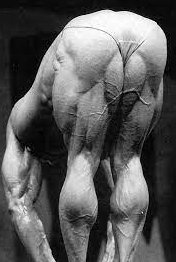
This position is banned in the IFBB Pro League and NPC because it is too vulgar. As the name suggests, this position highlights all the differences and stripes on the back of the leg. The pose was made famous by Tom Platz, who basically turned his back on the judges, put his knees together, and touched his toes. Wherever this position occurs, there is a full moon.
Christmas Tree Pose
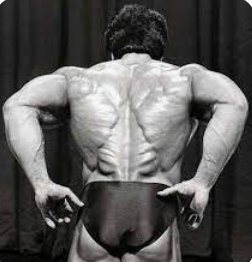
Similar to the dorsal expansion, the idea is to flex the lats with emphasis on the lower back. Actually, it involves more hip activation than chest activation. If done correctly, the lumbar muscles look almost like a Christmas tree.
The Kneel
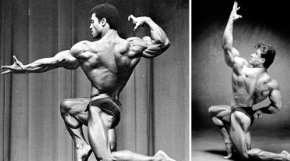
This is perhaps one of the most famous bodybuilding positions, but also one of the least talked about. You may have seen "The Kneel" in some media. Simply put, the bodybuilder kneels to the side and shows off most of his muscles. The athlete can flip to show the back or rotate to show the front. While the legs are the main attraction of this pose, it also works well to balance your abs and show off your upper body.
Quad Stomp
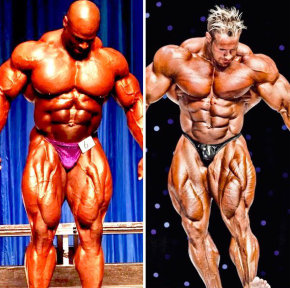
One of the coolest optional bodybuilding poses a bodybuilder can do is the "Quad Stomp." Jay Cutler debuted this move at his 2009 Olympia. In a true display of power, the bodybuilder robotically raised his leg and then began lowering it by flexing all of his leg muscles at the same time. It's a super straight position, but be careful not to extend your leg too much! If you do the posture well, you will be able to see all the fibers of your leg. Plus, he looks great on stage.
Quarter turn
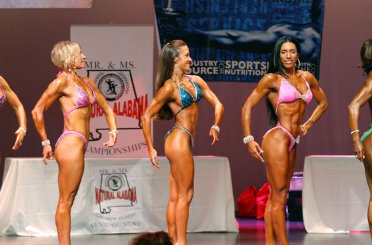
Bodybuilding postures for beginners.
When people think of bodybuilders, the quarter turn is most likely the first thing they imagine. In any advertisement or poster, there is always a group of guys doing the quarter turn. While it's the easiest thing to do, it's also the easiest thing to screw up. Basically, you show your side profile by turning slightly forward. This highlights toughness in the abs, chest, and obliques. Plus, it highlights all your imperfections... (so be careful).
Victory Pose
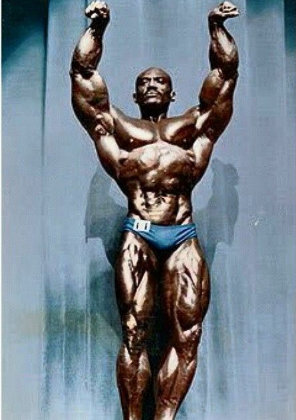
Raise your arms and flex your forearms with your palms facing away from your body. This is a classic bodybuilding pose and the most characteristic posture of bodybuilder Sergio Oliva.
Are you interested? :
Final conclusions on "posing" in bodybuilding
Bodybuilding is, subjectively, the same as any other sporting competition. As in any sport, you train to be in top shape for the competition. However, instead of lifting the bar off the floor and above your head to do one rep (aka Olympic lifting), you pose and basically show off your hard work in the gym. Posing is a skill-based demonstration of form and technique. In the case of bodybuilding, it is the ability to display muscle definition and development.
On stage, bodybuilders perform individually or sometimes all together in front of a panel of judges who evaluate their physiques. It takes incredible confidence to stand half naked in front of hundreds of people. Even more so to flex your muscles while being convinced that you are the most aesthetically pleasing man or woman on stage. The competition is similar to a fashion show. A bodybuilder's hard work is judged, and just like walking down a runway, posing helps show off that work.
Posing videos with natural bodybuilders
Every bodybuilder is proud of his size. When the goal is to constantly grow and improve your body, the hallmark of success is showing defined muscle mass. Posing is the best way to show off symmetry, definition, and body mass for the bodybuilder. For example, when you show your biceps, you make a fist, raise your elbow and press down. TRUE? You don't let the hand just slide to the side.
It is true that not everyone has perfect genetics. Fortunately, in bodybuilding , postures are a great way to combat genetic deficiencies. You can play with your body to show the true size and best possible appearance of your muscles. You can also have an added advantage if you are able to pose in a pure and harmonious style. This is why it is so important for bodybuilders to practice the postures.
Bodybuilding is a tough and exhausting sport. Without a doubt, bodybuilders train harder than other athletes. No muscle can be neglected! You should not skip leg training day and be successful. You can't just train your arms and chest every day. You can't just do some exercises either. You have to train hard, eat well, use periodization and progressive overload and, above all, be consistent for years. Every fiber of every muscle is important to achieve volume and symmetry. Our muscles are there to be shown!
In conclusion, knowing how to pose during a bodybuilding show is essential for competition. When you train all year round, your hard work will be appreciated. The ultimate goal is to show off your muscular and symmetrical body , and there is nothing better than the eight mandatory poses to achieve it.
Are you interested? :
Just as exhausting as posing is being starved and dehydrated for a bodybuilding competition! But if we have passion, we can do anything. Feel free to create your own poses and have fun with them. Personal posing is the true mark of a bodybuilding legend.







